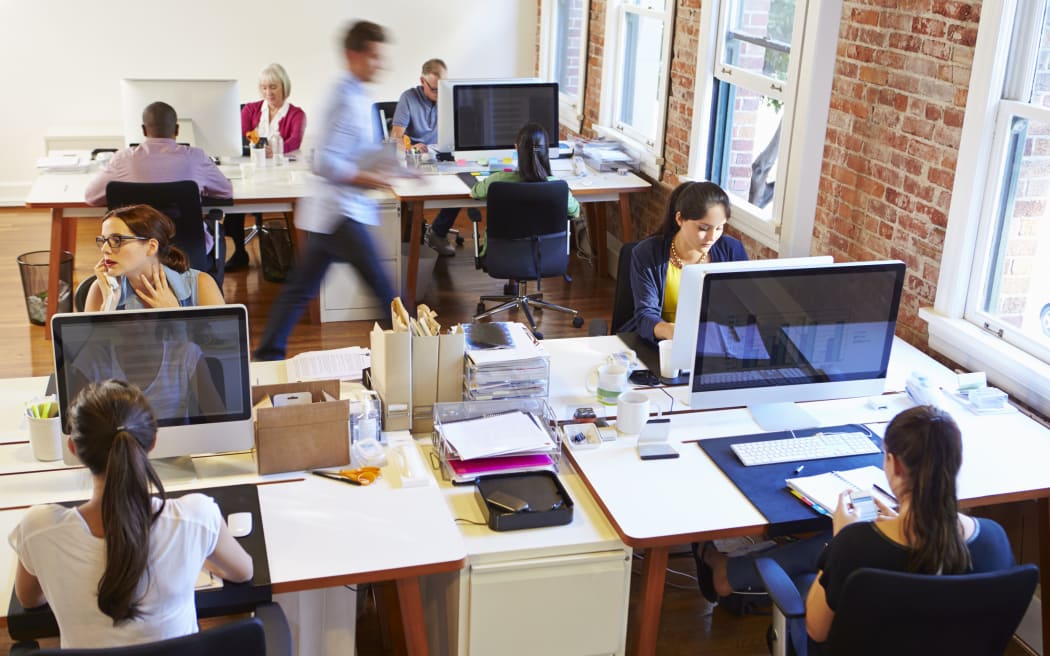Taking an “exercise snack” every half hour could be the key to counteracting the ill-effects of our sedentary work lives, a US journalist and researcher says.
Manoush Zomorodi, the host of the TED Radio Hour on NPR, has a new series called the Body Electric that looks at the negative impacts our digital habits have on our anatomy and what we can do about it.
The average adult spends 11 hours a day using some sort of technology and a lot of that is sitting down and she wanted to find out what sitting and working with tech was doing to our bodies “physically, from top to toe,” she tells Jesse Mulligan.

Photo: 123rf
“It's my journey through the human body to understand its relationship to our technology, to our habits, and what we need to do about it.”
Whatever humans have done for work in the past has affected us physically, she says.
“Go back hundreds of thousands of years, we’re hunter-gatherers, we're lean, we're mean, we have excellent eyesight, we can see really far because we are either being hunted, or we are hunting ourselves.”
By the early part of the 20th century, you have people sitting down as they earn a living, she says.
“And then of course, you bring in the computers the ‘70s, ‘80s and ‘90s and that completely changes not just the fact that we're sitting but contorts our bodies into using them certain ways.”
And contorting our bodies to accommodate the desk, keyboard, mouse set-up most of us work with does significant harm, she says.
“We start contorting our bodies to our tools, and we do it for hours and hours at a time.”
The World Health Organization predicts that by 2040, 40 percent of the entire population of the world will be near-sighted, she says.
“We don't go outside, we don't look into the distance anymore, we don't get vitamin D. One historian I talked to describes us as having Anthropocene bodies.
“He used one crazy statistic that in the UK, in certain areas, people don't walk for more than 10 minutes in a month.
“So, we're at the risk of turning into lumps of flesh.”
And a daily workout won’t reverse the damage, she says.
“Researchers have found that even if you work out in the morning or after work, if you are sitting the rest of the day, it doesn't make a difference, you still will have the potential health effects of having a sedentary lifestyle.”
Those ill-effects include hypertension and obesity, The key is to move a little regularly, she says, and this is backed by science.
“The sitting posture, I've heard it compared to a garden hose, if you kink a garden hose the water doesn't come through.
“Well, when you sit, you're putting a bend in your arteries at knee level. And so, blood is pooling in your legs and the pressure is increasing.
“This can have harmful effects on the blood vessels in your legs to the point that there is some preliminary research that suggests that sitting for hours on end, can actually damage the inner linings of your blood vessels.”
Sitting is a “slow-moving train wreck for your health,” she says.
“If you continue to expose your body to higher blood sugar levels and higher blood pressure levels, it catches up with you.
“So, your blood needs to flow because that's how it moves things it gets rid of the lipids and glucose muscles regulate blood sugar and the fat in our bloodstream.
“But to do so they have to be used, they need to be contracted, they need to be stimulated, which is why the jury's out on standing desks, just standing is still stagnant.
“It's this gentle movement. It doesn't have to be crazy. You can shuffle side to side or go get the laundry out of the dryer that you've been meaning to fold all day or just get up and you know, go check on what's happening out the window. It's literally just moving.”
To find out how this can be applied in the real world, her podcast is partnering with Colombia University Medical Center.
“We've enrolled 20,000 people into a study where they are signed up to one of three cohorts. One cohort is trying to get movement snacks into their workday every half hour - five minutes every half hour - another is five minutes every hour, and another is five minutes every two hours.”
Pulling in so many people from all walks of life has super-charged the research, she says.
“They are going to be able to complete the next phase of their research in about a month, this is really fast-tracking the science.”

